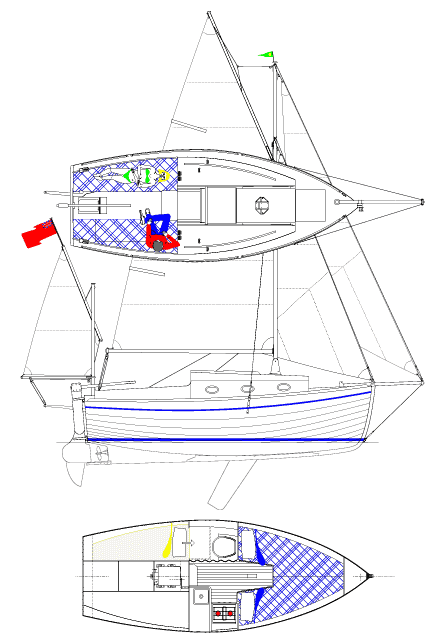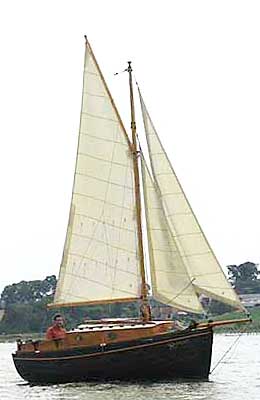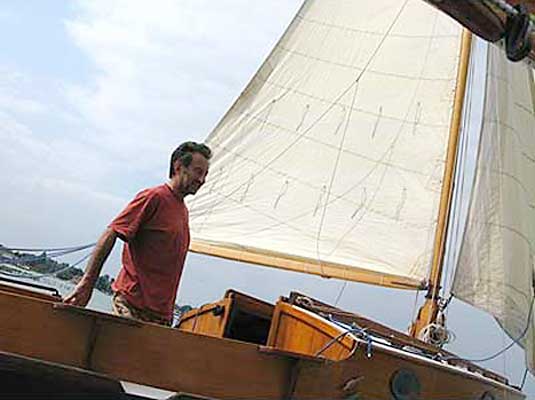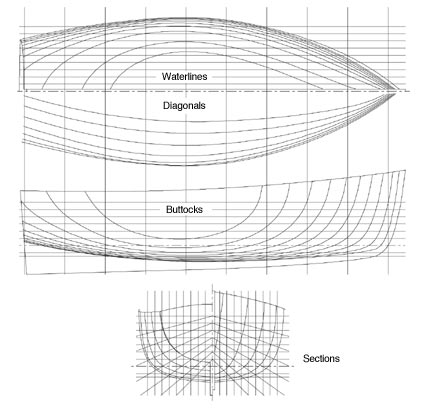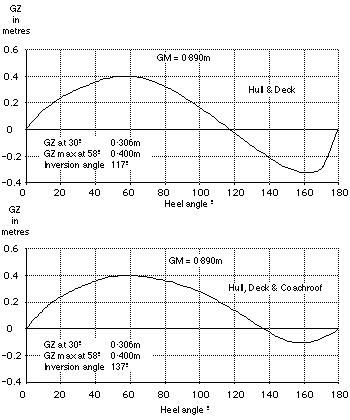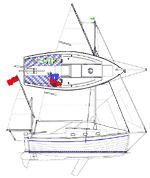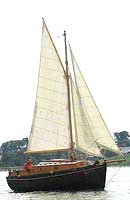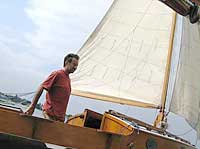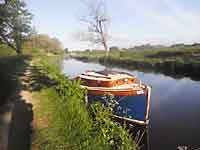| Specification | ||
|---|---|---|
| LOA exc. bowsprit | 5.354 m | 17'6¾" |
| LWL | 4.988 m | 16'4⅜" |
| Beam | 2.074 m | 6'9⅝" |
| Draught, board up | 0.400 m | 1'3¾" |
| Draught, board down | 1.200 m | 3'11¼" |
| Displacement on dwl | 739 kg | 1629 lbs |
| Ballast | 217 kg | 478 lbs |
| Main area | 10.019m² | 107.84ft² |
| Mizzen area | 2.334m² | 25.12ft² |
| Jib area | 4.010m² | 43.16ft² |
| Staysail area | 3.365m² | 36.22ft² |
| Headroom | 1.370 m | 4'5⅞ |
| Outboard (in well) | 3-4.5 kw | 4-6 hp |
| Engine | 7.5 max kw | 10 max hp |
| EU Category C - Inshore | ||
Design No. 119 – 5.354m (17'6¾") 3-berth yawl
Design 119 was the original of our pocket cruiser range. The design brief asked for:- a small, affordable classic gaff-rig cruising yacht
- easy trailing with a family car
- simple and quick to launch and rig, and to recover
- comfortable cruising accommodation with 3 full length berths
- good sitting headroom
- provision for a marine toilet
- usuable galley with sink and stove
- full-size self-draining cockpit, with decent lockers
- reliable performance under power
- fun sailing in light airs, yet able to cope with heavier weather
- modern wood-epoxy construction
- suitable for professional or amateur building
To our delight, the design was an immediate success and the boat itself performed beyond our expectations, both under sail and under power. Designers put a lot of themselves into a design so it is always a pretty good feeling when the result is well received.
Sea trials are always a mix of excitement and apprenhension for both the builder and the designer – let alone the owner – and with the first boat of a new design there is always just that extra degree of worry for the designer. Over the years, I have been either the designer or the builder (and sometimes both) of upwards of 70 launches and sea trials of new boats, mostly custom, ranging from quite small up to about 100' and the frisson of the moment never dulls.
So it was with just a little trepidation that I helped launch and rig the first of these boats on a calm, misty morning on the River Orwell, near Ipswich, England. We stepped the mast and set up the rigging with the boat on her trailer and then backed her into the water: she slid gently off the trailer, bobbed her bow a couple of times and settled into her natural element. The first hurdle was over – she floated where she should and trimmed nicely. Unfortunately we didn't take any photos at the time (1995) – however we do have a couple of images here of the same boat sailing on the River Deben 14 years later in 2009, though with very little wind.
Under sail she gives real big-boat performance and we constantly have to remind ourselves that she is, in reality, quite a small boat. Lively and fun to sail in light airs, she tuckers down in heavier weather. She handles perfectly under power, with a nice turn of speed, and she steers well both ahead and going astern. The outboard in its well in the cockpit is unobtrusive, convenient and reliable. Because the propeller is buried deep behind the keel, she also motor-sails very successfully even in quite rough conditions.
Since that time this design has become justifiably popular and has been built in the UK, USA, Canada, Australia, Europe, and Asia. “This is the eleventh boat that I’ve built and your plans and instructions are the best I’ve seen....” Bob Trygg, Minnesota USA – a builder of Design 119, No. 9 in 1997, shown here, the first to be built with a cold-moulded skin. Click for a slide show of photos of this boat. When it loads it will be on "Pause"; hit "Play" to set it going. You can also move manually backwards and forwards through the slides. When you close the window, it's best to leave the slideshow on Pause else it will still be running in the background.
KES, built in the UK cruised as a motor boat on Britain's inland waterways for a few seasons before being rigged for sailing. She is fitted with an inboard diesel engine. Click for a slide show of photos of KES. When it loads it will be on "Pause"; hit "Play" to set it going. You can also move manually backwards and forwards through the slides. When you close the window, it's best to leave the slideshow on Pause else it will still be running in the background.
Owners are always surprised at the real spaciousness of this boat. Accommodation is for three, with full length comfortable berths, although with a tent over the boom there is also a camper accommodation for two in the full-size cockpit. After the first few boats, we changed from ply frames to laminated frames as this gives a more flexible interior layout. We also modified the mast frame so that no mast post is required, which meant that the two forward berths could easily be turned into a double berth with an infill piece. The galley features a sink unit with stowage beneath and a cook stove unit, again with stowage beneath.
There are two toilet options in the plans. An inboard-facing toilet in a simple box between the forward berth and the quarterberth – in which case the forward end of the quarterberth is fixed. And an aft-facing toilet, again in a box with a hinged lid, but in this case the forward end of the quarterberth moves away to give footroom aft of the toilet. The second arrangement can have a privacy curtain if wished. If a completely separate compartment is required, either Design No. 146, or Design No. 165, will fulfil this.
Click here to look at the free study plans, sample instructions and specification for this design, plus a full list of the plans and instructions that come with the design package.

